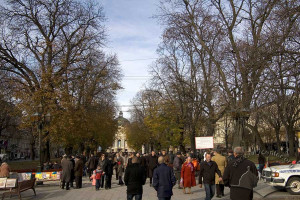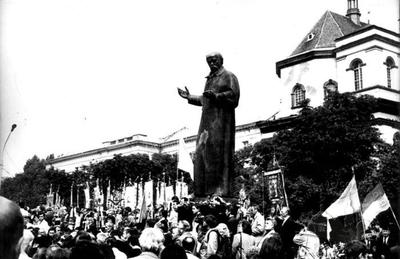Prosp. Svobody – monument to Taras Shevchenko ID: 113
The monument to the Ukrainian national poet was opened on 24 August 1992. By 1996, it was complemented with a 12-meter decorative stele with reliefs, supposed to symbolize the wave of national revival.
Story
The first initiatives to erect a monument to Taras Shevchenko in Lviv (in particular, near the building of the NTSh on present-day vul. Vynnychenka, 24) arose in the late 19th c. Throughout the Soviet period, the options for installing a monument to the poet were considered. The decision on the construction of the monument was approved on 22 June 1987, but due to unsuccessful competitions it was established later, in independent Ukraine.
The fundraising and construction was conducted by the Ukrainian Public Committee under the leadership of Vasyl Ivanytskyi. The sculpture was made in Argentina. The authors of the monument were sculptors Andriy and Volodymyr Sukhorski, the architects were Yuriy Dyba and Yuriy Kromey.
Architecture
The monument is located on prospect Svobody on the place, where, before 1950, an
equestrial monument
was erected to the Polish king Jan III Sobieski; during
the Soviet period, there was a
Unlike the monument to Sobieski, the monument to Shevchenko is shifted to the eastern edge of the square. It stands out against the background of the old city buildings due to its dark, almost black color, and the Wave of National Revival somewhat competes, in view of its height, with the bell tower of the former Jesuit church. The monument is supplemented by the surrounding area, paved with granite tiles of several kinds.
Related buildings and spaces
Sources
- Ігор Мельник, Роман Масик, Пам'ятники і меморіальні таблиці міста Львова, (Львів: Апріорі, 2012), 91-94














